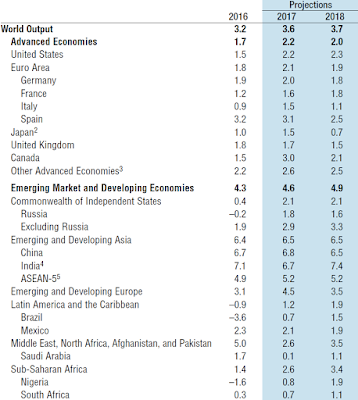Here in Namibia, we’ve grown used to
examining the reports released out by Statistician General Alex Shimuafeni and
the Namibia Statistics Agency to gauge our economic health. Unfortunately, our
own health does not paint a complete picture – the country, after all, does not
exist in isolation, but is part of the global economy. Where then would we look
to find out how the rest of the world is doing? Well, the World Economic Studies
Division of the Research Department at the International Monetary Fund in
Washington DC can help us on that front. Every 6 months, they release a World
Economic Outlook to inform us as to how the world is doing, economically.
So what does the October 2017 report
reveal? Well, after struggling through most of 2016 at a paltry 3.2% growth, it
appears the world economy is picking up steam again, with 2017 growth expected
to be 3.6%. Central Banks across the world have begun tightening monetary
policy again (raising interest rates) as growth slowly returns, but it’s not
all good news. It remains problematic that not all countries are participating
in the recovery, and while growth is increasing, inflation – and specifically,
wage inflation – remains low. This means that the new growth is not being
funnelled to the ordinary people, and economic inequality is on the increase.
So let’s dig a bit deeper into the details,
starting with the so-termed ‘Advanced Economies.’ In the United States, growth
for 2017 is expected to increase to 2.2%, less than expected, as President
Trump’s election promised of fiscal policy expansion has yet to come to pass.
Further hampering the US’s growth is its lack of productivity growth and aging
workforce. In the Euro area, growth is expected to rise to 2.1% on the back of
a growth in exports and smaller political risk. However, similar to the US,
weak productivity growth and an aging workforce will stymie growth, alongside
the problem of excessive debt still faced by some countries in the Euro area.
In the United Kingdom, growth is expected
to drop to 1.7% going forward, with the pounding taken by the Pound Sterling
depressing consumption. With Brexit details not yet confirmed, future growth is
also likely to be muted until the extent of the country’s relationship with the
euro area is finalised. Japan is similarly on a downward path, with expected
growth of 1.5%, but going forward, the country’s shrinking labour force will
curtail growth. In other advanced economies, growth accelerates, however, with
Norway (1.4%), Canada (3%), Australia (2.2%), Korea (3%) and Singapore (2.5%)
benefitting from the recovery in global trade.
Now let’s have a look at the Emerging
Market Economies. First amongst these is of course China, with growth projected
to be 6.8%, well on their way to their target of doubling GDP between 2010 and
2020. However, much of this growth has been funded by debt, which has
ballooned, so risks increase there as well. In the rest of Asia, the economies
are doing quite well too, with India being a standout, despite still
experiencing disruptions associated with their currency exchange initiative,
and they’re expected to grow by 6.7% this year.
In Latin America and the Caribbean, GDP
growth is returning to 1.2% in 2017 after contracting by 1% in 2016. Mexico leads the way in this region, even
though a renegotiation of the NAFTA agreement is on the cards, and Brazil is
once again experiencing economic growth as well. The biggest issue in the
region is the continuing political uncertainty in Venezuela, whose economy is
expected to contract by 10% in 2017. In the Commonwealth of Independent States
(or Russia and the former USSR countries) conditions continue to improve, with
growth in the region expected to be 2.1%. This coincides with Russia finally
struggling out of its two-year recession, with expected growth of 1.8%.
In developing Europe, growth is expected to
be 4.5%, driven by a recovery in exports, and lead by Turkey (5.1%) and Poland
(3.8%). In the Middle-East and North African region, however, growth is slowing
to 2.6% from 5% in 2016, mainly due to a renormalization of Iran’s growth after
it sped up significantly in 2016 after sanctions ended. Pakistan is expected to
lead in growth, with 5.3% expected in 2017 due to investment in the
Pakistan-China Economic Corridor.
Finally, our own neck of the woods –
sub-Saharan Africa. By now we have good comparisons with the rest of the world
to show just how we’re doing. Well, the region as a whole is expected to grow
by 2.6% this year, but we have sizable differences between countries, and the
big outliers are Nigeria, which is only now starting to recover from the oil
price shocks of 2016, with growth for 2017 projected at 0.8%. South Africa, the
other large economy, is also facing growth of just 0.7% despite recoveries in
the commodities markets and agricultural exports on the rise due to good rains.
However, the political uncertainty continues to sap not only consumer
confidence, but growth as well. Angola, on the other hand, will grow by about
1.5% this year, off the back of a rebound in oil production, and for the rest
of the region, an average growth of 3.9% is expected this year.
So what does this mean for us? When we take
a step back to see the whole world economy at a glance, we can see that no one
economy is without its challenges. But we can also see that every recession has
a solution, with quite a few countries pulling themselves up by their
bootstraps. We’ve been blessed with quite a few years of exceptional growth,
and now seem stuck in a recession. But the proof is out there. If we Harambee,
we too can return to solid growth.


No comments:
Post a Comment